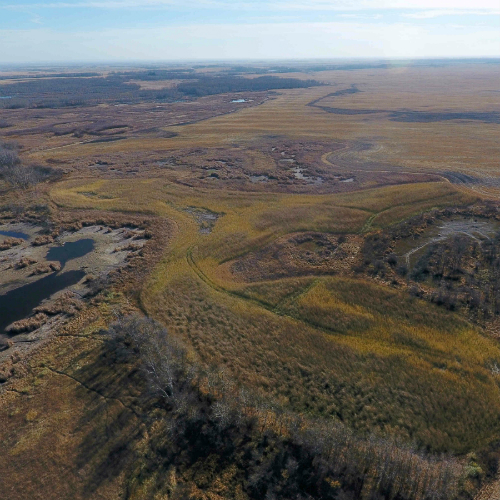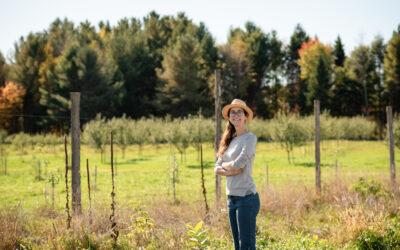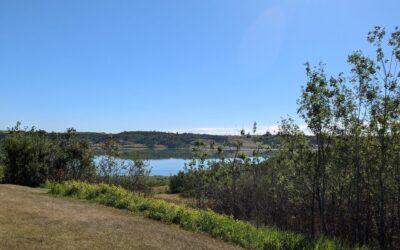ALUS Canada’s 2017 Prairie Hub Field Conference a success in Saskatchewan.
By Paige Englot, ALUS Canada Prairie Hub Manager

ALUS Canada’s 2017 Prairie Hub Conference, hosted by the community of ALUS Saskatchewan Assiniboine Project (ASAP). From L to R, back row: Paige Englot (ALUS Canada), Caitlyn Peters (ASAP), Casey Whitelock (ALUS Canada), Christine Campbell (ALUS Canada), Alysha Lockhart (ALUS WUQWATR), Colleen Cuvelier (ALUS Little Saskatchewan River), Folly Baugh (ALUS WUQWATR). Front row: Michelle Primus (ALUS Canada), Lynn Bishop (ALUS Canada), Gord Hammell (ALUS Little Saskatchewan River), Ray Frey (ALUS Little Saskatchewan River).
Every year, ALUS Canada brings together ALUS Program Coordinators from across the Prairies and staff from across the nation to share experiences and develop ways to optimize the delivery of the ALUS program in Manitoba and Saskatchewan.
In 2017, the ALUS community known as the ALUS Saskatchewan Assiniboine Project, or ASAP, hosted the Prairie Hub Conference in Yorkton, Saskatchewan. Guests included ALUS Canada’s three Hub Managers, Director of Grants and Funding and Director of Operations, as well as Program Coordinators, PAC members and staff representing ALUS Canada’s three Prairie communities— ASAP and ALUS WUQWATR from Saskatchewan, and ALUS Little Saskatchewan River from Manitoba.
Attendees workshopped ideas for optimizing the delivery of the ALUS program in the Prairies, including ways for ALUS participants to enhance the ecosystem services they produce on the ground, and various administrative improvements for local ALUS community structures.
Our conversation about ways to optimize the ALUS program in the Prairies continued outdoors, during a field trip to ALUS sites that provided perfect examples of how the ALUS program works with farmers to produce cleaner air, cleaner water, more biodiversity and other valuable ecosystem services in local communities.
Located north of Churchbridge in the Assiniboine watershed, ALUS participant Randy Slager has enrolled nearly 50 acres into the ALUS program, including 20 acres of enhanced wetlands, 23 surrounding acres of wildlife habitat, and another five acres that have been retired from grain production and planted with a mixture of deep-rooted plants to serve as a buffer zone between the wetlands and the farm fields.
ASAP’s Program Coordinator, Jesse Nielsen, practiced his flight skills and captured some great drone images of Slager’s ALUS projects, as shown here.

Using a drone, ASAP’s Program Coordinator Jesse Nielsen captured a bird’s eye view of ALUS participant Randy Slager’s project sites, including more than 45 acres of enhanced wetlands, trees and grasslands in Saskatchewan’s beautiful Assiniboine Watershed.
Attendees went from a bird’s eye view to a hands-on demonstration of ecosystem services being produced on a 4,200-acre farm in Bangor, just east of Melville and an hour south of Yorkton, where ALUS participant Gary Richards has enrolled more than 110 acres into the ALUS program, including 30 acres of wetland projects and 60 acres of wildlife habitat.
On one of these sites, ALUS helps Richards maintain an area of marginal cropland that has been transitioned from annual cultivation to a no-till blend of perennial plant species. Above ground, these plants now provide habitat for many native wildlife species and help prevent soil from eroding into streams and waterbodies. Below ground, their deep and extensive root systems help improve soil health and sequester carbon.
Cool winds and fallen leaves may have signified the end of the growing season, but the green foliage we saw at these ALUS sites continued to harvest the sun late into the fall, even after the Prairie Hub Field Conference drew to a close. And now, as the Prairies emerge from an extended winter hibernation, the photosynthesis machine is already active on all ALUS projects, gearing up for another season of ecosystem services production.

Attendees of the ALUS Prairie Field Conference discuss the importance of soil health in capturing carbon, filtering water and increasing the biodiversity of soil microorganisms, which are just a few of the ecosystem services produced by Gary Richards’ ALUS projects.



